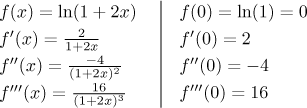Problem: Find the Taylor polynomial of degree 3 and of degree n
with center
f (x) = ln(1+2x).
Solution: The Taylor polynomial at a of degree 3 is given by the formula
![]()
So we need to calculate the first three derivatives and then substitute

We substitute this and a into the general formula and obtain
![]()
Now we will look at the problem of guessing the Taylor polynomial of degree n. For simple problems it might be possible to guess correctly from the Taylor polynomial of degree 3 or 4, but here it might be tricky, so we will show a procedure that is quite reliable. The main trick is to look not at the numbers in the right column above but at the left column, identifying individual factors that keep appearing at each step of the derivative. What happens when we differentiate? We will redo the above derivatives to see the process.

We should now see the pattern. With each derivative we get an extra 2, an
extra (−1) and then an increasing string of multiplied numbers, giving rise
to a factorial. We also notice that we get the 2 exactly as many times as is
the degree of the derivative, but the power at (−1) and the factorial are
smaller by 1. The power at
![]()
We check that it agrees with the first three derivatives we calculated at the
beginning, so it seems reasonable that it is correct, just to be on the safe
side we will prove it by mathematical induction. For

This proves that our guess concerning the

Check that the first three terms of this general formula agree with our T3 above.
Remark: There is an easier way to get Tn. One
of the classical results that can be found in pretty much every textbook
dealing with Taylor polynomials is the Taylor polynomial for the function

If we substitute in

Remark: This is a nice example that one has to be careful when
approximating using Taylor polynomials. If we use this approximation
at